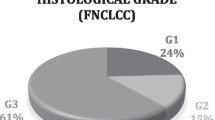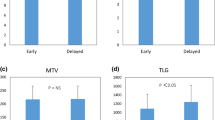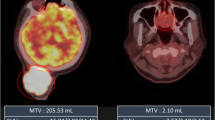Abstract
Background
Soft-tissue sarcomas (STS) represent a diverse group of rare malignancies, underscoring the need for precise risk stratification. [18F]fluoro‑2‑deoxy‑2‑d‑glucose positron emission tomography ([18F]FDG PET) imaging parameters have been proposed as potential prognostic indicators in several cancer types, yet their significance in STS remains under investigation. This study aimed to synthesize the available evidence and assess the prognostic value of these parameters.
Methods
A systematic review and meta-analysis was conducted, employing a comprehensive literature search across multiple databases. The prognostic value of [18F]FDG PET parameters, including pre- and post- treatment standardized uptake values (SUV1, SUV2), pretreatment metabolic tumor volume (MTV1) and total lesion glycolysis (TLG1) on event-free survival (EFS) and overall survival (OS) in patients with STS was examined.
Results
Thirty-one studies with 1,932 patients were identified. The analyses demonstrated significant relationships between higher SUV1 (hazard ratio, HR 1.68 for EFS and 3.07 for OS, p < 0.001), SUV2 (HR 3.13 for EFS and 2.09 for OS, p < 0.001 and p = 0.001 respectively), MTV1 (HR 2.29 for EFS and 3.05 for OS, p = 0.011 and p < 0.001 respectively), TLG1 (HR 2.85 for EFS and 3.23 for OS, p = 0.032 and p = 0.002 respectively) and poorer survival outcomes. However, the association of these parameters with survival outcomes was non-significant in pediatric patients.
Conclusion
This study suggests that [18F]FDG PET parameters could serve as important prognostic markers in adults with STS, but not in pediatric patients. Future studies with larger cohorts and uniform methodologies are critical to confirm and build upon these findings.



Similar content being viewed by others
Availability of data and materials
The authors declare that all data supporting the findings of this study are available within the article.
Abbreviations
- [18F]FDG:
-
[18F]fluoro‑2‑deoxy‑2‑d‑glucose
- CI:
-
Confidence interval
- EFS:
-
Event-free survival
- FNCLCC:
-
Fédération Nationale des Centres de Lutte Contre Le Cancer Sarcoma Group
- HR:
-
Hazard ratio
- IQR:
-
Interquartile range
- M:
-
Multicenter
- Me:
-
Median
- MTV:
-
Metabolic tumor volume
- NA:
-
Not applicable
- NAC:
-
Neoadjuvant chemotherapy
- NR:
-
Not reported
- OS:
-
Overall survival
- PET:
-
Positron emission tomography
- Pro:
-
Prospective
- Prov:
-
Provided
- REML:
-
REstricted Maximum–Likelihood
- Retro:
-
Retrospective
- RMS:
-
Rhabdomyosarcoma
- ROC:
-
Receiver operating characteristic curve
- S:
-
Single center
- SD:
-
Standard deviation
- STS:
-
Soft-tissue sarcoma
- SUV:
-
Standardized uptake value
- TLG:
-
Total lesion glycolysis
- TSA:
-
Trial sequential analysis
References
Seldon C, Shrivastava G, Al-Awady A et al (2021) Variation in management of extremity soft-tissue sarcoma in younger vs older adults. JAMA Netw Open. https://doi.org/10.1001/jamanetworkopen.2021.20951
Ferrari A, Brennan B, Casanova M et al (2022) Pediatric non-rhabdomyosarcoma soft tissue sarcomas: standard of care and treatment recommendations from the European Paediatric Soft Tissue Sarcoma Study Group (EpSSG). Cancer Manag Res 14:2885–2902. https://doi.org/10.2147/CMAR.S368381
Kunisada T, Nakata E, Fujiwara T et al (2023) Soft-tissue sarcoma in adolescents and young adults. Int J Clin Oncol 28:1–11. https://doi.org/10.1007/s10147-022-02119-7
Burningham Z, Hashibe M, Spector L, Schiffman JD (2012) The epidemiology of sarcoma. Clin Sarcoma Res 2:1–16. https://doi.org/10.1186/2045-3329-2-14
Ray-Coquard I, Serre D, Reichardt P et al (2018) Options for treating different soft tissue sarcoma subtypes. Futur Oncol 14:25–49. https://doi.org/10.2217/fon-2018-0076
Grünewald TG, Alonso M, Avnet S et al (2020) Sarcoma treatment in the era of molecular medicine. EMBO Mol Med. https://doi.org/10.15252/emmm.201911131
Ducimetière F, Lurkin A, Ranchère-Vince D et al (2011) Incidence of sarcoma histotypes and molecular subtypes in a prospective epidemiological study with central pathology review and molecular testing. PLoS ONE. https://doi.org/10.1371/journal.pone.0020294
Jacobs AJ, Michels R, Stein J, Levin AS (2015) Improvement in overall survival from extremity soft tissue sarcoma over twenty years. Sarcoma. https://doi.org/10.1155/2015/279601
Zagars GK, Ballo MT, Pisters PWT et al (2003) Prognostic factors for patients with localized soft-tissue sarcoma treated with conservation surgery and radiation therapy: an analysis of 1225 patients. Cancer 97:2530–2543. https://doi.org/10.1002/cncr.11365
Toulmonde M, Bonvalot S, Méeus P et al (2014) Retroperitoneal sarcomas: Patterns of care at diagnosis, prognostic factors and focus on main histological subtypes: a multicenter analysis of the French Sarcoma Group. Ann Oncol 25:735–742. https://doi.org/10.1093/annonc/mdt577
Uslu L, Donig J, Link M et al (2015) Value of18F-FDG PET and PET/CT for evaluation of pediatric malignancies. J Nucl Med 56:274–286. https://doi.org/10.2967/jnumed.114.146290
El-Kholy E, El Nadi E, Hafez H et al (2019) Added predictive value of 18F-FDG PET/CT for pediatric rhabdomyosarcoma. Nucl Med Commun 40:898–904. https://doi.org/10.1097/MNM.0000000000001040
Casey DL, Wexler LH, Fox JJ et al (2014) Predicting outcome in patients with rhabdomyosarcoma: role of [18F]fluorodeoxyglucose positron emission tomography. Int J Radiat Oncol Biol Phys 90:1136–1142. https://doi.org/10.1016/j.ijrobp.2014.08.005
Park JY, Lee JW, Lee HJ et al (2017) Prognostic significance of preoperative 18F-FDG PET/CT in uterine leiomyosarcoma. J Gynecol Oncol 28:28. https://doi.org/10.3802/jgo.2017.28.e28
Hack RI, Becker AS, Bode-Lesniewska B et al (2021) When suv matters: Fdg pet/ct at baseline correlates with survival in soft tissue and ewing sarcoma. Life. https://doi.org/10.3390/life11090869
Lim HJ, Johnny Ong CA, Tan JWS, Ching Teo MC (2019) Utility of positron emission tomography/computed tomography (PET/CT) imaging in the evaluation of sarcomas: a systematic review. Crit Rev Oncol Hematol 143:1–13. https://doi.org/10.1016/j.critrevonc.2019.07.002
Li YJ, Dai YL, Cheng YS et al (2016) Positron emission tomography (18)F-fluorodeoxyglucose uptake and prognosis in patients with bone and soft tissue sarcoma: a meta-analysis. Eur J Surg Oncol 42:1103–1114. https://doi.org/10.1016/j.ejso.2016.04.056
Kubo T, Furuta T, Johan MP, Ochi M (2016) Prognostic significance of 18F-FDG PET at diagnosis in patients with soft tissue sarcoma and bone sarcoma; systematic review and meta-analysis. Eur J Cancer 58:104–111. https://doi.org/10.1016/j.ejca.2016.02.007
Chen L, Wu X, Ma X et al (2017) Prognostic value of 18F-FDG PET-CT-based functional parameters in patients with soft tissue sarcoma a meta-analysis. Med (United States). https://doi.org/10.1097/MD.0000000000005913
Okazumi S, Dimitrakopoulou-Strauss A, Schwarzbach MHM, Strauss LG (2009) Quantitative, dynamic 18F-FDG-PET for the evaluation of soft tissue sarcomas: relation to differential diagnosis, tumor grading and prediction of prognosis. Hell J Nucl Med 12:223–228
Lyra V, Chatziioannou S, Kallergi M (2022) Clinical perspectives for18 F-FDG PET imaging in pediatric oncology: μetabolic tumor volume and radiomics. Metabolites. https://doi.org/10.3390/metabo12030217
Liberati A, Altman DG, Tetzlaff J et al (2009) The PRISMA statement for reporting systematic reviews and meta-analyses of studies that evaluate health care interventions: explanation and elaboration. PLoS Med. https://doi.org/10.1371/journal.pmed.1000100
Khoury JD, Coffin CM, Spunt SL et al (2010) Grading of nonrhabdomyosarcoma soft tissue sarcoma in children and adolescents: a comparison of parameters used for the Fédération Nationale des Centers de Lutte Contre le Cancer and Pediatric Oncology Group systems. Cancer 116:2266–2274. https://doi.org/10.1002/cncr.24929
Tierney JF, Stewart LA, Ghersi D et al (2007) Practical methods for incorporating summary time-to-event data into meta-analysis. Trials 8:16. https://doi.org/10.1186/1745-6215-8-16
Higgins JPT, Thomas J, Chandler J et al (2019) Cochrane handbook for systematic reviews of interventions. Cochrane Handb Syst Rev Interv. https://doi.org/10.1002/9781119536604
Harbord RM, Higgins JPT (2008) Meta-regression in Stata. Stata J 8:493–519. https://doi.org/10.1177/1536867x0800800403
De Cassai A, Tassone M, Geraldini F et al (2021) Explanation of trial sequential analysis: using a post-hoc analysis of meta-analyses published in Korean Journal of Anesthesiology. Korean J Anesthesiol 74:383–393. https://doi.org/10.4097/KJA.21218
CLARITY-group. Tool to Assess Risk of Bias in Case Control Studies Hamilton, Ontario: McMaster University. https://www.evidencepartners.com/wp-content/uploads/2021/03/Tool-to-Assess-Risk-of-Bias-in-Case-Control-Studies-DistillerSR.pdf. Accessed 14 Jul 2023
McGuinness LA, Higgins JPT (2021) Risk-of-bias VISualization (robvis): an R package and Shiny web app for visualizing risk-of-bias assessments. Res Synth Methods 12:55–61. https://doi.org/10.1002/jrsm.1411
Egger M, Smith GD, Schneider M, Minder C (1997) Bias in meta-analysis detected by a simple, graphical test. Br Med J 315:629–634. https://doi.org/10.1136/bmj.315.7109.629
Foroutan F, Guyatt G, Zuk V et al (2020) GRADE Guidelines 28: use of GRADE for the assessment of evidence about prognostic factors: rating certainty in identification of groups of patients with different absolute risks. J Clin Epidemiol 121:62–70. https://doi.org/10.1016/j.jclinepi.2019.12.023
FDA (2019) Pediatric Medical Devices | FDA. https://www.fda.gov/medical-devices/products-and-medical-procedures/pediatric-medical-devices. Accessed 14 Jul 2023
Andersen KF, Fuglo HM, Rasmussen SH et al (2015) Semi-quantitative calculations of primary tumor metabolic activity using F-18 FDG PET/CT as a predictor of survival in 92 patients with high-grade bone or soft tissue sarcoma. Med (United States). https://doi.org/10.1097/MD.0000000000001142
Andersen KF, Fuglo HM, Rasmussen SH et al (2015) Volume-Based F-18 FDG PET/CT imaging markers provide supplemental prognostic information to histologic grading in patients with high-grade bone or soft tissue sarcoma. Med (United States). https://doi.org/10.1097/MD.0000000000002319
Andreou D, Boldt H, Pink D et al (2014) Prognostic relevance of 18F-FDG PET uptake in patients with locally advanced, extremity soft tissue sarcomas undergoing neoadjuvant isolated limb perfusion with TNF-α and melphalan. Eur J Nucl Med Mol Imaging 41:1076–1083. https://doi.org/10.1007/s00259-013-2680-8
Annovazzi A, Ferraresi V, Covello R et al (2023) Prognostic value of pre-treatment [18F]FDG PET/CT texture analysis in undifferentiated soft-tissue sarcoma. J Clin Med. https://doi.org/10.3390/jcm12010279
Chang KJ, Lim I, Park JY et al (2010) The role of 18F-FDG PET/CT as a prognostic factor in patients with synovial sarcoma. Nucl Med Mol Imaging 49:33–41. https://doi.org/10.1007/s13139-014-0301-5
Chen D, Tang M, Lv S et al (2022) Prognostic usefulness of clinical features and pretreatment 18F-FDG PET/CT metabolic parameters in patients with angiosarcoma. Quant Imaging Med Surg 12:2792–2804. https://doi.org/10.21037/qims-21-563
Cheriyalinkal Parambil B, Shah S, Prasad M et al (2023) Can 18F-FDG-positron emission tomography be a prognostic tool in children with rhabdomyosarcoma treated with definitive radiotherapy? J Pediatr Hematol Oncol 45:E363–E369. https://doi.org/10.1097/MPH.0000000000002565
Choi ES, Ha SG, Kim HS et al (2013) Total lesion glycolysis by 18F-FDG PET/CT is a reliable predictor of prognosis in soft-tissue sarcoma. Eur J Nucl Med Mol Imaging 40:1836–1842. https://doi.org/10.1007/s00259-013-2511-y
Dharmarajan KV, Wexler LH, Gavane S et al (2012) Positron emission tomography (PET) evaluation after initial chemotherapy and radiation therapy predicts local control in rhabdomyosarcoma. Int J Radiat Oncol Biol Phys 84:996–1002. https://doi.org/10.1016/j.ijrobp.2012.01.077
Fayolle H, Jehanno N, Lauwers-Cances V et al (2022) PET metabolic tumor volume as a new prognostic factor in childhood rhabdomyosarcoma. PLoS ONE. https://doi.org/10.1371/journal.pone.0261565
Fendler WP, Lehmann M, Todica A et al (2015) PET response criteria in solid tumors predicts progression-free survival and time to local or distant progression after chemotherapy with regional hyperthermia for soft-tissue sarcoma. J Nucl Med 56:530–537. https://doi.org/10.2967/jnumed.114.152462
Ha SC, Oh JS, Roh JL et al (2017) Pretreatment tumor SUVmax predicts disease-specific and overall survival in patients with head and neck soft tissue sarcoma. Eur J Nucl Med Mol Imaging 44:33–40. https://doi.org/10.1007/s00259-016-3456-8
Harrison DJ, Chi YY, Tian J et al (2021) Metabolic response as assessed by 18F-fluorodeoxyglucose positron emission tomography-computed tomography does not predict outcome in patients with intermediate- or high-risk rhabdomyosarcoma: a report from the Children’s Oncology Group Soft Tissue Sarcom. Cancer Med 10:857–866. https://doi.org/10.1002/cam4.3667
Herrmann K, Benz MR, Czernin J et al (2012) 18F-FDG-PET/CT imaging as an early survival predictor in patients with primary high-grade soft tissue sarcomas undergoing neoadjuvant therapy. Clin Cancer Res 18:2024–2031. https://doi.org/10.1158/1078-0432.CCR-11-2139
Hong SP, Lee SE, La CY et al (2014) Prognostic value of 18F-FDG PET/CT in patients with soft tissue sarcoma: comparisons between metabolic parameters. Skeletal Radiol 43:641–648. https://doi.org/10.1007/s00256-014-1832-7
Jo SJ, Kim KD, Lim SH et al (2022) The role of preoperative 18F-fluorodeoxyglucose positron emission tomography/computed tomography in retroperitoneal sarcoma. Front Oncol. https://doi.org/10.3389/fonc.2022.868823
Kalisvaart GM, Grootjans W, Bovée JVMG et al (2021) Prognostic value of quantitative [18 f]fdg-pet features in patients with metastases from soft tissue sarcoma. Diagnostics. https://doi.org/10.3390/diagnostics11122271
Kato A, Nakamoto Y, Ishimori T et al (2020) Prognostic value of quantitative parameters of 18F-FDG PET/CT for patients with angiosarcoma. Am J Roentgenol 214:649–6549. https://doi.org/10.2214/AJR.19.21635
Kitao T, Shiga T, Hirata K et al (2019) Volume-based parameters on FDG PET may predict the proliferative potential of soft-tissue sarcomas. Ann Nucl Med 33:22–31. https://doi.org/10.1007/s12149-018-1298-0
Lisle JW, Eary JF, O’Sullivan J, Conrad EU (2009) Risk assessment based on FDG-PET imaging in patients with synovial sarcoma. Clin Orthop Relat Res 467:1605–1611. https://doi.org/10.1007/s11999-008-0647-z
Rhu J, Hyun SH, Lee KH et al (2019) Maximum standardized uptake value on 18 F-fluorodeoxyglucose positron emission tomography/computed tomography improves outcome prediction in retroperitoneal liposarcoma. Sci Rep 9:1–10. https://doi.org/10.1038/s41598-019-43215-5
Sambri A, Bianchi G, Longhi A et al (2019) The role of F-FDG PET/CT in soft tissue sarcoma. Nucl Med Commun 40:626–631. https://doi.org/10.1097/MNM.0000000000001002
Tateishi U, Kawai A, Chuman H et al (2011) PET/CT allows stratification of responders to neoadjuvant chemotherapy for high-grade sarcoma: a prospective study. Clin Nucl Med 36:526–532. https://doi.org/10.1097/RLU.0b013e3182175856
Umemura H, Yamasaki O, Kaji T et al (2017) Prognostic value of 18F-fluorodeoxyglucose positron emission tomography/computed tomography in patients with cutaneous angiosarcoma: a retrospective study of 18 cases. J Dermatol 44:1046–1049. https://doi.org/10.1111/1346-8138.13839
Wakamatsu T, Imura Y, Tamiya H et al (2021) 18F-fluorodeoxyglucose positron emission tomography is useful in the evaluation of prognosis in retroperitoneal sarcoma. Cancers (Basel). https://doi.org/10.3390/cancers13184611
Yamamoto M, Tsujikawa T, Yamada S et al (2017) 18F-FDG/18F-FES standardized uptake value ratio determined using PET predicts prognosis in uterine sarcoma. Oncotarget 8:22581–22589. https://doi.org/10.18632/oncotarget.15127
Hayes DF, Isaacs C, Stearns V (2001) Prognostic factors in breast cancer: current and new predictors of metastasis. J Mammary Gland Biol Neoplasia 6:375–392. https://doi.org/10.1023/A:1014778713034
Vesselle H, Turcotte E, Wiens L et al (2004) Relationship between non-small cell lung cancer fluorodeoxyglucose uptake at positron emission tomography and surgical stage with relevance to patient prognosis. Clin Cancer Res 10:4709–4716. https://doi.org/10.1158/1078-0432.CCR-03-0773
Oprea-Lager DE, Kramer G, Van De Ven PM et al (2016) Repeatability of quantitative 18F-fluoromethylcholine PET/CT studies in prostate cancer. J Nucl Med 57:721–727. https://doi.org/10.2967/jnumed.115.167692
Song H, Jiao Y, Wei W et al (2019) Can pretreatment 18F-FDG PET tumor texture features predict the outcomes of osteosarcoma treated by neoadjuvant chemotherapy? Eur Radiol 29:3945–3954. https://doi.org/10.1007/s00330-019-06074-2
Rijo-Cedeño J, Mucientes J, Álvarez O et al (2020) Metabolic tumor volume and total lesion glycolysis as prognostic factors in head and neck cancer: systematic review and meta-analysis. Head Neck 42:3744–3754. https://doi.org/10.1002/hed.26461
Wen W, Piao Y, Xu D, Li X (2021) Prognostic value of MTV and TLG of 18F-FDG PET in patients with stage I and II non-small-cell lung cancer: a meta-analysis. Contrast Media Mol Imaging. https://doi.org/10.1155/2021/7528971
Pak K, Cheon GJ, Nam HY et al (2014) Prognostic value of metabolic tumor volume and total lesion glycolysis in head and neck cancer: a systematic review and meta-analysis. J Nucl Med 55:884–890. https://doi.org/10.2967/jnumed.113.133801
Bailly C, Leforestier R, Campion L et al (2017) Prognostic value of FDG-PET indices for the assessment of histological response to neoadjuvant chemotherapy and outcome in pediatric patients with Ewing sarcoma and osteosarcoma. PLoS ONE 12:e0183841. https://doi.org/10.1371/journal.pone.0183841
Pan M, Merchant M (2018) Risk factors including age, stage and anatomic location that impact the outcomes of patients with synovial sarcoma. Med Sci. https://doi.org/10.3390/MEDSCI6010021
Janeway KA, Barkauskas DA, Krailo MD et al (2012) Outcome for adolescent and young adult patients with osteosarcoma: a report from the Children’s Oncology Group. Cancer 118:4597–4605. https://doi.org/10.1002/CNCR.27414
Cotterill SJ, Ahrens S, Paulussen M et al (2000) Prognostic factors in Ewing’s tumor of bone: analysis of 975 patients from the European Intergroup Cooperative Ewing’s Sarcoma Study Group. J Clin Oncol 18:3108–3114. https://doi.org/10.1200/JCO.2000.18.17.3108
Macpherson RE, Pratap S, Tyrrell H et al (2018) Retrospective audit of 957 consecutive 18F-FDG PET–CT scans compared to CT and MRI in 493 patients with different histological subtypes of bone and soft tissue sarcoma. Clin Sarcoma Res. https://doi.org/10.1186/s13569-018-0095-9
Li CP, Liu DN, Zhou NN et al (2021) Prediction of histologic subtype and FNCLCC grade by SUVmax measured on 18F-FDG PET/CT in patients with retroperitoneal liposarcoma. Contrast Media Mol Imaging. https://doi.org/10.1155/2021/7191363
Im HJ, Bradshaw T, Solaiyappan M, Cho SY (2018) Current methods to define metabolic tumor volume in positron emission tomography: which one is better? Nucl Med Mol Imaging 52:5. https://doi.org/10.1007/S13139-017-0493-6
Reyes Marlés RH, Navarro Fernández JL, Puertas García-Sandoval JP et al (2021) Clinical value of baseline 18F-FDG PET/CT in soft tissue sarcomas. Eur J Hybrid Imaging. https://doi.org/10.1186/S41824-021-00110-5
Acknowledgements
None
Funding
The authors did not receive support from any organization for the submitted work.
Author information
Authors and Affiliations
Contributions
MY, YL contributed to the design and implementation of the research. MY, LB, ER preformed the analysis of the results. MY, LB, ER, DK, YL wrote of the manuscript. All authors discussed the results and commented on the manuscript.
Corresponding author
Ethics declarations
Conflict of interest
The authors have no relevant financial or non-financial interests to disclose.
Ethical approval and consent to participate
Not applicable.
Consent for publication
Not applicable.
Additional information
Publisher's Note
Springer Nature remains neutral with regard to jurisdictional claims in published maps and institutional affiliations.
Supplementary Information
Below is the link to the electronic supplementary material.
Rights and permissions
Springer Nature or its licensor (e.g. a society or other partner) holds exclusive rights to this article under a publishing agreement with the author(s) or other rightsholder(s); author self-archiving of the accepted manuscript version of this article is solely governed by the terms of such publishing agreement and applicable law.
About this article
Cite this article
Yadgarov, M.Y., Berikashvili, L.B., Rakova, E.S. et al. Prognostic significance of [18F]FDG PET metabolic parameters in adults and children with soft-tissue sarcoma: a meta-analysis. Clin Transl Imaging (2024). https://doi.org/10.1007/s40336-024-00620-9
Received:
Accepted:
Published:
DOI: https://doi.org/10.1007/s40336-024-00620-9




